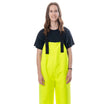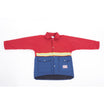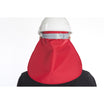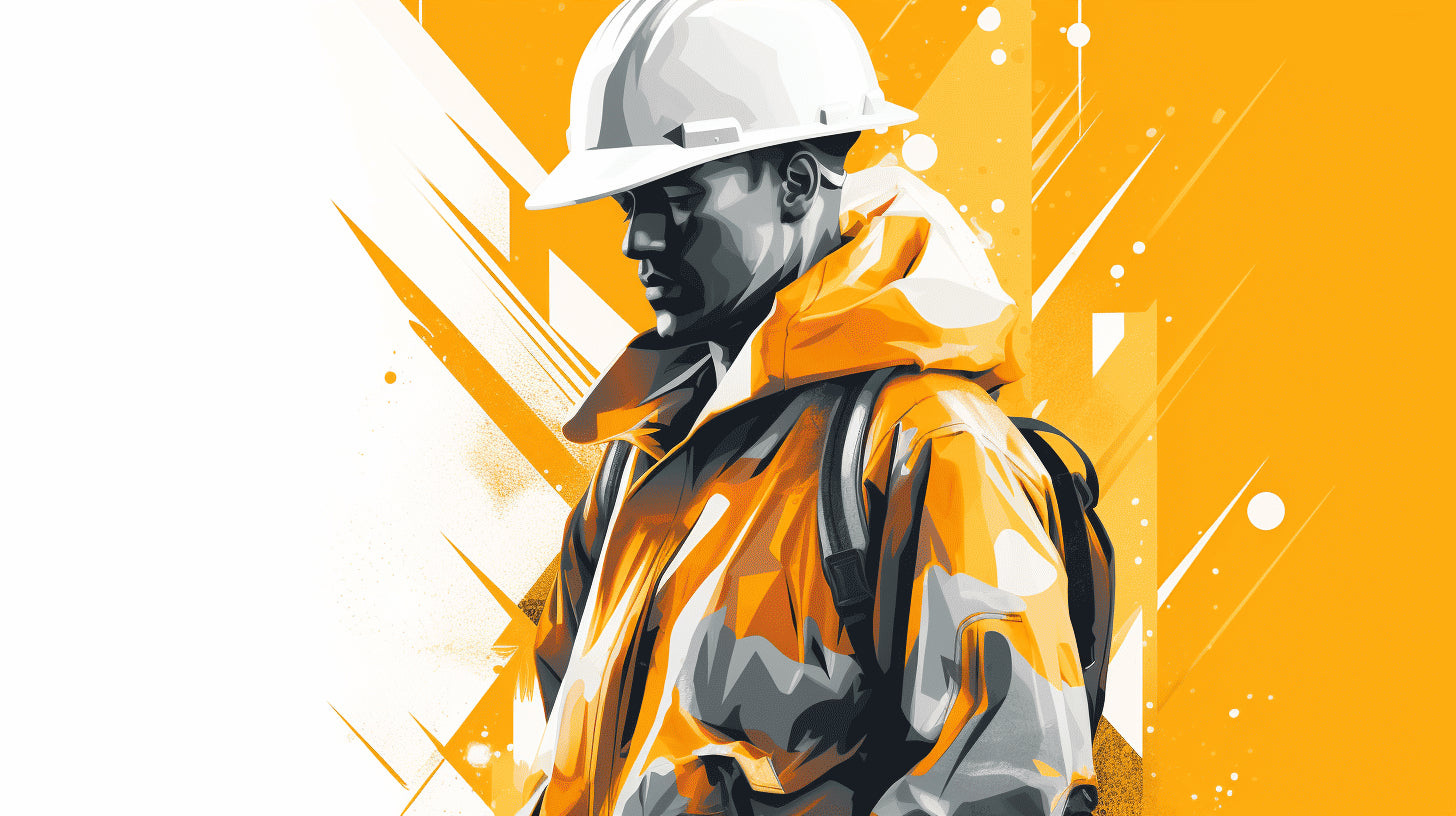Built to last and designed to protect, the right rain gear is essential for every construction worker. Battling elements is an inevitable part of working on a construction site, and rain is a common foe that can transform a typical workday into a trying ordeal. Yet, with quality waterproof and tear-resistant rain gear, construction workers can ensure their safety, comfort, and efficiency, no matter what the forecast holds.
This guide delves into the crux of rain gear for construction work—from the demand and environmental impact to your best material options and budget-friendly alternatives. We will uncover maintenance tips to extend their lifespan, delve into the protective technologies employed, and explore safety features tailor-made for construction workers. As well, we will shed light on industry-specific selections, ensuring you make an informed decision based on your unique needs on the job site.
Here's to staying dry and productive, no matter how heavy the downpour gets! Let’s splash right into the heart of the matter.
Importance and Demand of Rain Gear in Construction
Being part of the construction industry, you're well-acquainted with the primal role weather conditions play in our everyday tasks. In a field where outdoor work is mandatory, there's no weather too harsh for our determined workforce. But even the most resolute of individuals require their armor. In the face of unpredictable weather, that armor comes in the form of quality rain gear.
Rain gear isn't just some arbitrary part of a construction worker's wardrobe. It proves instrumental in maintaining productivity levels on rain-soaked days. Dependable rain gear ensures that construction workers remain dry, comfortable, and safe, enabling them to continue their tasks without any hindrance. And, with the recent fluctuations we've noticed in weather conditions, the importance of reliable rain gear in the construction industry has never been more pronounced.
Now, let's dissect the essentials of this rain gear phenomenon in the industry:
- Protection: High-quality rain gear provides an essential shield against the elements. It keeps workers dry in the pouring rain, allowing them to continue their tasks unaffected.
- Comfort: More than just keeping workers dry, good rain gear maintains comfort. It uses breathable materials that avoid excess perspiration, keeping the body temperature balanced.
- Visibility: Often rain gear in construction comes in bright, reflective colors adding an extra layer of safety in adverse visibility conditions.
- Durability: Quality rain gear stands the test of time and repeated use. This durability makes it a worthwhile investment for any company looking to keep their workers protected and productive.
An intriguing point relating to our conversation is the value data of rain gear. There's an observable pattern in sales volumes of rainwear that echoes the rise and fall of weather changes. A particularly wet season sees a sharp rise in demand, reinforcing the gear's value to the industry.
In the world of construction, the importance of quality rain gear cannot be overstated. Weather conditions may be unpredictable, but our preparedness doesn't have to be. Armed with durable and reliable rain gear, construction workers can face all weather adversities with boosted confidence and uninterrupted productivity. Remember, it's not just about staying dry; it's about ensuring comfort, safety, and efficiency on those rainy workdays.
Reducing Environmental Impact of Rain Gear
An unexpected downpour can significantly dampen our outdoor pursuits. Equipping ourselves with trendy, waterproof rain gear may seem like the ideal solution; however, the environmental cost often tends to lessen the charm. Luckily, several eco-friendly alternatives are now becoming prevalent.
The environmental impact associated with traditional rain gear stems from the manufacturing process and materials used. A common concern is that they often include Per- and polyfluoroalkyl substances (PFAS). PFAS are a group of man-made chemicals used in many different products for their water-resistant and non-stick properties. Unfortunately, these substances don't break down easily, leading to environmental contamination and potential human health risks.
However, recent improvements in technology and increased environmental consciousness have spurred changes in the rain gear industry. Let's explore these eco-friendlier alternatives.
PFAS-Free Materials
Today, rain gear manufacturers have started adopting PFAS-free materials.
- These materials provide the much-needed water resistance while reducing the environmental impact.
- Substituting PFAS with safer alternatives, gear made from these materials does not pollute water or soil.
- Thus, they're a sustainable choice for consumers who want to enjoy the rainy season without compromising the planet's wellbeing.
The journey toward eco-friendly rain gear may be filled with challenges, but the industry is making steady progress. With each passing day, more manufacturers are embracing the responsibility that comes with producing rain gear.
Remember, our choices can echo in time, inspiring change, and leading to a more sustainable world. For us, it's merely about selecting a raincoat. But for Mother Earth, it's a step towards healing and rejuvenation. Stay dry, stay green!
Manufacturers' steps towards developing PFAS-free materials for rain gear are applaudable. They're not only offering solutions for water-resistance but also serving an environmental cause – and as consumers, it's our job to support that mission!
Materials Preferred for Construction Rain Gear
The decision to choose the right construction rain gear can be seen as a pivotal aspect of performing construction professions effectively. The elements directly, and indirectly, dictate how the projects unfold. Downpours, if not well considered, can bring operations to a grinding halt or, even worse, result in avoidable health and safety issues. Therefore, understanding the types of materials best equipped to ward off such unnecessary setbacks has become an integral part of the construction sphere.
Notably, materials such as Ripstop polyester, Oxford fabric, and waterproof membranes have gained considerable popularity in the market. A closer look at their properties will reveal why they are often favored in producing construction rain gear.
Ripstop Polyester
First on our list is Ripstop Polyester. This material's structured weaves are deliberately reinforced to prevent tears and frays, proving to be a pawn against water ingress. This makes Ripstop polyester highly regarded for its tear-resistant quality—a crucial factor for the physically demanding nature of construction work.
- Tear and Fading Resistance: The distinct squares in its weaves provide a unique design that ensures tear resistance, a characteristic much desired by those in the construction field.
- Waterproof: Ripstop Polyester's water-resistant feature is remarkable. It guards adequately against downpours, ensuring construction workers can perform their duties unhindered by weather conditions.
Oxford Fabric
Next in line is the Oxford fabric—a highly durable material known for its strength and longevity. Superior to ordinary cloth materials, Oxford fabric's tight weave offers potent water resistance, making it another excellent choice for construction rain gear.
- Sturdiness and Durability: Oxford fabric has a storied reputation for being strong and durable—precisely what you would desire from your rain gear to weather rough construction environments.
- Excellent Water Resistance: Its tightly woven nature provides a high level of water resistance, ensuring you remain dry even in a heavy downpour.
Waterproof Membranes
Lastly, we delve into waterproof membranes, specifically, those with taped seams like Gore-Tex. These membranes are designed to be wholly water-resistant. They prevent water ingress while allowing sweat to escape, keeping you comfortable in your rain gear.
- Water Resistance: Being main features, they are impervious to water, keeping you dry throughout.
- Breathability: Unlike many other materials, waterproof membranes offer optimal breathability, an essential feature for comfort during intensive work.
Let's not forget durable PVC-coated polyester—its superior water resistance coupled with its high durability makes this material another fantastic choice for construction rain gear.
By investing in rain gear made from these materials, construction professionals can ensure they are well prepared for any weather condition. However, it's not simply about choosing the right gear but about comprehending their components. In the struggle against mother nature, knowledge is power. Stay informed, stay dry, and most importantly, stay safe.
Maintenance of Rain Gear
Rain gear, a true savior in the wild streak of monsoons, usually tends to lose its charm when not taken care of properly. If you're an outdoor enthusiast who often faces the wrath of rain, it's crucial to know the essence of proper rain gear maintenance. Cleaning and maintaining these suitable shields not only ensure longevity but also retain their crucial water resistance feature, the one that really counts when the raindrops start tapping on your head.
Many an umbrella or raincoat ends up in a landfill prematurely, all because of lack of maintenance or improper care. In most cases, your rain gear doesn’t need to be completely replaced - just a little TLC goes a long way to revive their functionality. Beyond monetary savings, maintaining rain gear is also a step towards more sustainable living, limiting our unnecessary contribution to landfills.
Maintaining rain gear can feel like a challenge, but in reality, it's all about understanding the needs of the different materials. Here are some primary tips to keep your rain gear in top shape:
Regular Cleaning
Cleaning your rain gear regularly with gentle, mild soap, and lukewarm water can go a long way in prepping it for longevity. Avoid harsh detergents as they can degrade the waterproof materials.
Proper Drying
Allow your gear to completely air dry after every use, but stay clear of excessive heat or sunlight. High temperatures can cause the waterproof layer to deteriorate sooner.
Waterproofing Treatments
Over time, the factory waterproofing on your gear might begin to lose its efficiency. Regularly applying a specialized waterproofing treatment can help restore this essential feature.
Storage
Properly storing your gear when not in use also contributes significantly to their durability. Always pack away your gear dry, and avoid cramming it into tight spaces.
"As with any valuable tool, your rain gear deserves your utmost attention and care. It's your critical line of defense against the unpredictable nature of rain."
The most crucial tip, after all, is that the maintenance process can be tweaked based on the type of rain gear you own and your level of usage. At the end of the day, it's all about observing the condition of your gear and responding with the right maintenance practices promptly. Now that you're aware of how to keep your rain gear sturdy for the long haul, don't let a little downpour dampen your spirit. With your trusty rain gear by your side, you're all set to tackle those unexpected showers head-on.
Budget-Friendly Alternatives for Waterproof Footwear
It's a scenario familiar to anyone who lives in a climate where rain is a frequent occurrence. You check the weather in the morning, see there's a chance of showers, and rue the fact that your shoes aren't waterproof. Does that mean you're destined to have damp feet for the rest of the day? Not necessarily. Thankfully, there are budget-friendly alternatives to expensive waterproof boots that can keep your feet dry and your bank account full.
First, let's consider waterproof shoes with durable soles. These might be a slightly more expensive option upfront compared to regular shoes, but their durability and waterproof abilities can save you money in the long run. How, you might wonder? By keeping your feet dry and preventing you from constantly replacing shoes damaged by water.
- Durable Soles: This variety of waterproof shoes uses thick rubber on the soles to prevent water seepage. Durable materials like vulcanized rubber and leather often come into the mix. Plus, sturdy soles can withstand rough terrains and long walks, offering you a double benefit.
Another cost-effective option could be making your regular shoes waterproof. Yes, you read it right. Turning your existing shoes into waterproof ones is possible with the assistance of specialized sprays or wax.
- Waterproof Sprays: These sprays form a protective layer on the surface of the shoes, shielding them from water. They might need periodic re-application, but their price and effectiveness make them a practical choice.
- Wax: Using a waterproofing wax can offer your shoes a sturdy protective layer. It not only amplifies water resistance but also enhances the shoes' life and shine. Be aware though, waxes are usually better for leather shoes and may darken the shoe color slightly.
Bear in mind that these solutions can save you significant money, but they do have some limitations. They might not offer the same level of water protection as an expensive pair of waterproof boots, especially in heavy rain or if you're stepping in deep puddles. But for light to moderate rain, you'll find they're more than adequate.
As you can see, there's no need to splash out on a costly pair of rain boots to keep your feet dry. Whether you opt for waterproof shoes with durable soles or decide to make your regular shoes water-resistant with a spray or wax, these alternatives can keep both your feet and your wallet happy.
Different Technologies Used in Professional Rain Gear
Rainy days can be a real nuisance, but they've got nothing on the power of today's professional rain gear. If you're expecting another PVC or rubber-coated promo item, then fasten your seatbelts because we're about to dive into the exciting world of high-end rain gear technology. This includes the grit of ripstop nylon, the reliability of GORE-TEX INFINIUM WINDSTOPPER, and the resilience offered by signature fabric technologies.
Ripstop Nylon
Ripstop nylon is a hero in the rain gear world. It's specially woven to resist tearing and ripping, making it a sturdy choice for weather-reliable clothing. While some might associate nylon with a slippery or plastic-like feel, ripstop nylon's unique cross-hatch pattern creates a rugged texture. Of note is its inherent lightweight nature, making it suitable for a range of outdoor gear, from backpacks to tents and, of course, rain jackets.
And despite its toughness, ripstop nylon still demands respect when it comes to breathability. While rubberized or PVC rain gear offers strong waterproofing, such items pale in comparison to the breathability of ripstop nylon. This is vital when you're out tackling the elements, as it ensures you stay dry, not just from the rain, but also from perspiration.
GORE-TEX INFINIUM WINDSTOPPER
Next in line is the GORE-TEX INFINIUM WINDSTOPPER — worth every syllable, considering its capabilities. This material is more than just a windbreaker; it's an all-in-one fabric that takes breathability, flexibility, and waterproofing seriously.
Perhaps you've heard of the various types of rain jacket construction, notably the 2, 2.5, and 3-layer designs. The beauty of the GORE-TEX INFINIUM WINDSTOPPER is that it brings the highest waterproofing abilities from the 3-layer construction, without adding unnecessary bulk. This piece of gear is compact and can be rolled up or folded without losing its shape or properties.
Signature Fabric Technology
Last, but certainly not least, we have the advanced signature fabric technologies. These technologies often incorporate a blend of popular materials, like the aforementioned ripstop nylon with added protective layers. One of the most impressive is silicone-coated nylon fabric or "silnylon". This fabric is a game-changer for lightweight yet waterproof gear. Silnylon is strong, tear-resistant, and one of the most uncompromisingly waterproof materials on the market.
In conclusion, professional rain gear has come a long way since the days of dull, rubbery raincoats. Ripstop nylon, GORE-TEX INFINIUM WINDSTOPPER and advanced signature fabric technologies are the testament to this evolution. With these technologies on your side, you can conquer any weather the day might throw at you. Now who's afraid of a little rain?
Rain Gear Safety Features for Construction Workers
Rain, snow, fog, or simply low-light conditions — construction workers continue their hard work against the elements. It comes as no surprise that suitable rain gear is their armor in maintaining productivity, but what often gets overlooked are the safety features these apparels come with. Here's where reflective and high-visibility rain gear kick in.
Visibility can be a major concern for construction workers in harsh weather conditions, especially when working on highways or near busy roads. This is where rain gear with reflective tape plays a big part. It's not just about staying dry; it's about staying seen too.
Reflective tape on safety gear does not only enhance visibility, but it plays a vital role in ensuring construction worker's safety. It boasts the following benefits:
- Makes workers more obvious: In low-light conditions or during the night time, reflective tape lights up, making the worker easily seen from a distance.
- Essential for work near traffic: For construction sites near or on roads, workers wearing rain gear with reflective tape can be spotted by motorists, reducing the risk for accidents.
- Increase sense of security: Knowing that they are visible to others can promote a sense of safety among workers, boosting their overall morale and productivity.
The role of high-visibility rain gear cannot be overstated either. High-visibility gear already has a solid reputation in worker safety, and when paired with rain gear, it's a match made in safety heaven. Harnessing reflective technology woven into the fabric, this gear illuminates workers against the backdrop of a busy worksite or gloomy sky, making it difficult for them to blend into the environment.
High-visibility rain gear with reflective technology has become a game-changer. It can significantly reduce the risk of accidents and enhance overall worker safety. It's truly a piece of clothing that doubles as a lifesaver.
So here's the takeaway: When it comes to safety wear in the construction industry, especially in inclement weather, don't underestimate the power of reflective tape and high-visibility gear. These features are much more than just add-ons. They are indispensable tools that champion safety and visibility in some of the toughest work conditions. Put simply, these simple features can make a huge difference when it comes to saving lives on the job. By making construction workers more visible, we're also making them safer.
Industry-Specific Rain Gear Options
When it comes to outdoor work, Mother Nature doesn't always cooperate with our schedules. Whether it's a drizzle or a downpour, rain can make a job downright challenging. That's when industry-specific rain gear comes into play. Depending on your industry, there are unique rain gear options precisely tailored to your on-the-job needs, enhancing both your productivity and safety. In particular, industries such as electric and gas utilities can opt for flame-resistant rain gear while flame-retardant variants are favored in environments that necessitate added safety precautions.
A Flame-Resistant Protection for Electric and Gas Utilities
Working in the electric and gas utilities industry means operating in potentially hazardous environments. Here, flame-resistant rain gear stands out as a critical safety outfit. These rainwear items are made with materials that resist catching fire while effectively shedding water, ensuring that workers remain dry and safe even under unfavorable conditions.
Key perks of flame-resistant rain gear include:
- Resistance to catch fire: These garments are designed to not quickly ignite and continue to burn after the ignition source is removed.
- Protection against electrical arc flashes: They provide a safety shield against electrical accidents, an essential factor for electric and gas industry workers.
- Comfort & mobility: While safety is paramount, these rain gear options also ensure workers' comfort and ease of movement, a significant aspect during weather-related disruptions.
Stepping Up the Safety with Flame-Retardant Gear
Certain work environments demand more than water protection; they require fire safety measures. For sectors involving high exposure to fire or heat, flame-retardant rain gear becomes the choice attire. Unlike flame-resistant options, these materials are chemically treated to self-extinguish once the flame source is removed. This feature reduces the likelihood of fire-related injuries, providing an extra layer of safety.
Benefits of flame-retardant rain gear include:
- Self-extinguishing properties: These outfits continue to protect even after initial flame exposure due to their self-extinguishing capability.
- Durable & long-lasting: Despite the chemical treatments, flame-retardant rain gear can withstand normal washing and wears without losing its protective properties.
- Versatility: They find applications in multiple sectors, including welding, oil, and gas industries, among others.
"Being prepared has always been my motto. The day you've prepared for is the day you're equipped to win." - Unknown
The right gear for the right job is not a luxury; it's a necessity when the elements are against you. So, whether you're facing a drizzle or a downpour, having a purpose-designed, industry-specific rain gear is essential in the storm of demands posed by your work. Arm yourself with the best rain gear tailored to your industry - because being prepared isn't only about weathering the storm, it's about performing at your peak despite it.
Conclusion
When it comes to construction work, having the right gear is everything. By investing in quality rain gear, like the ones offered by Hurricane Raingear, you're investing in your safety, comfort, and overall job satisfaction.
With modern fabric technologies in play, weather is no longer a hurdle. Professional rain gear like ripstop nylon and GORE-TEX INFINIUM WINDSTOPPER not only ensures durability but also comfort. Easy maintenance and budget-friendly alternatives further ease the overall experience of owning a rain gear.
And let's not forget safety features. Reflective 3M striping enhances visibility so you can focus on the task at hand without worrying about being seen in gloomy weather conditions. Indeed, the right rain gear not only protects you from inclement weather but it could also make your job easier, safer, and a lot more gratifying.
Building a solid framework for a sturdy structure requires one to remain dry and comfortable, and the right rain gear helps you do exactly that. Invest in quality, invest in your safety, invest in yourselves. Remember, a sound mind works best in a sound body, and a comfortable rain gear is here to ensure you just that. Protection is not expensive, it's priceless.
Note: The information provided in this article is not intended to replace the advice or guidance from professional safety advisors or insurance providers. Always seek advice from your safety advisor or insurance provider before making any decisions about your personal safety on the job site.
Frequently Asked Questions
-
What are the benefits of using waterproof and tear-resistant rain gear for construction?
Using waterproof and tear-resistant rain gear for construction offers several benefits, including protection against rain, durability in harsh conditions, increased comfort, and enhanced safety for workers.
-
What should I look for when buying waterproof and tear-resistant rain gear for construction?
When buying rain gear for construction, look for features such as waterproof and tear-resistant materials, taped seams, adjustable cuffs and hems, reflective strips for visibility, and reinforced areas prone to wear and tear.
-
Can I use regular rain gear for construction work?
While regular rain gear may offer basic protection against rain, it may not be suitable for construction work. Waterproof and tear-resistant rain gear specifically designed for construction provides added durability and enhanced safety features to withstand the demands of the job.
-
How should I maintain waterproof and tear-resistant rain gear?
To prolong the life of your rain gear, it is recommended to follow the manufacturer's instructions for care and maintenance. Generally, this involves regular cleaning, avoiding the use of harsh chemicals or heat, and storing the gear properly in a dry and ventilated area.
-
Are there different types of waterproof and tear-resistant rain gear available for construction?
Yes, there are various types of rain gear available for construction, including waterproof jackets, pants, suits, coveralls, boots, and gloves. The choice of gear depends on the specific needs and preferences of the workers and the nature of the construction work.





















Leave a comment
This site is protected by hCaptcha and the hCaptcha Privacy Policy and Terms of Service apply.